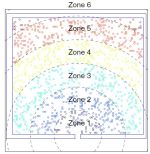EPJ B Highlight - Bottom-up insight into crowd dynamics
- Details
- Published on 04 February 2014

A new study proposes a method for quantitatively analysing the relative value of models for crowd dynamics prediction, following individual movement
Stampedes unfortunately occur on too regular a basis. Previously, physicists developed numerous models of crowd evacuation dynamics. Their analyses focused on disasters such as the yearly Muslim Hajj or of the Love Parade disaster in Germany in 2010. Unfortunately, the casualties at these events may have been linked to the limitations of the crowd dynamics models used at the time. Now, a new study outlines a procedure for quantitatively comparing different crowd models, which also helps to compare these models with real-world data. In a paper published in EPJ B, Vaisagh Viswanathan, a PhD student from Nanyang Technological University in Singapore, and colleagues have demonstrated that these crowd evacuation dynamics models are a viable decision-making tool in safety preparation and planning concerning real-world human crowds.
The trouble with such models is that they rely on real-world data of crowds that is limited and incomplete. Often only top-down, macroscopic scale measurements of data such as flow, density, and average speed are used. It is not clear whether these metrics can validate the modelled dynamics at the individual level.
Instead of using data that is so difficult to source, Viswanthan and colleagues adopted a quantitative study comparing the simulated congestion flow rates, among other things, of three so-called bottom-up models. These focus on the individual behaviour of school children evacuating their classroom during the May 2008 Sichuan Earthquake.
They found that a model referred to as the social force model — based on the idea that pedestrians move in response to fictitious attractive or repulsive social forces — best matches the real-world data showing how pupils exit their classrooms.
They also identified a new macroscopic metric, 'the zoned evacuation time', as the one observable parameter that can best discriminate between these models, and also between models and real-world data.
V. Viswanthan, C. E. Lee, M. Harold Lees, S. A. Cheong, and P. M. A. Sloot (2014), Quantitative Comparison Between Crowd Models for Evacuation Planning and Evaluation, European Physical Journal B, DOI 10.1140/epjb/e2014-40699-x




